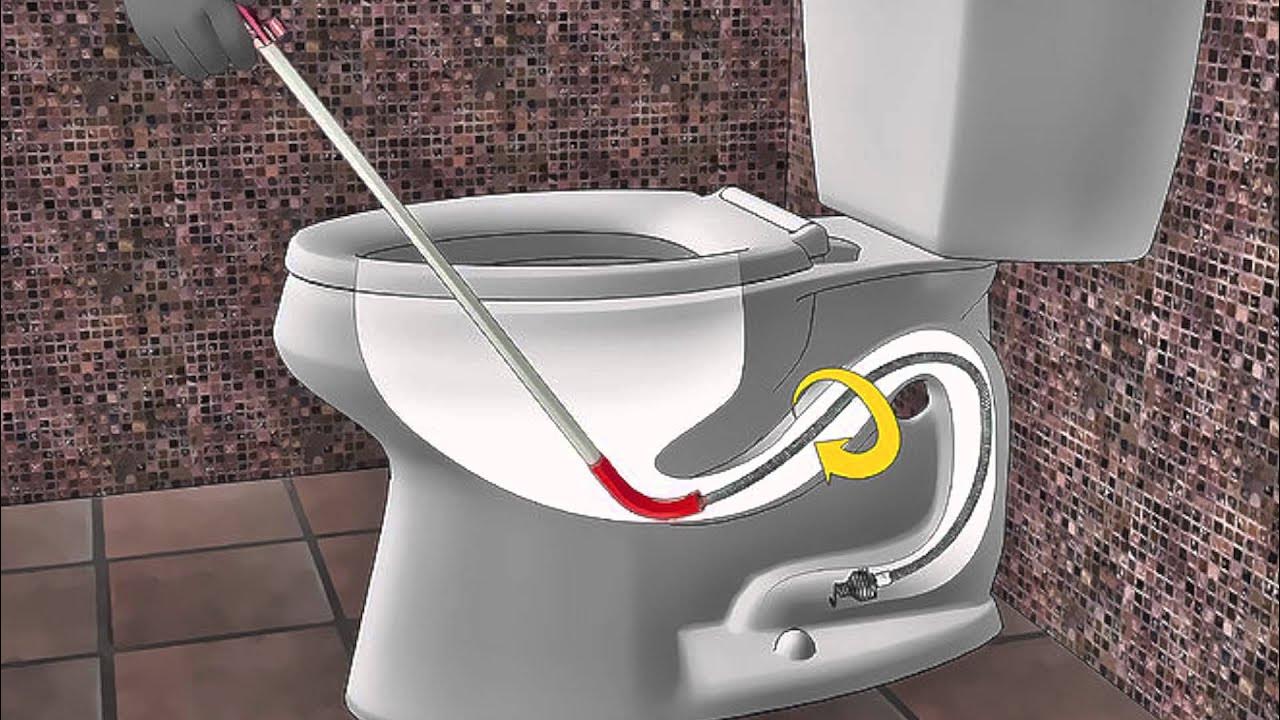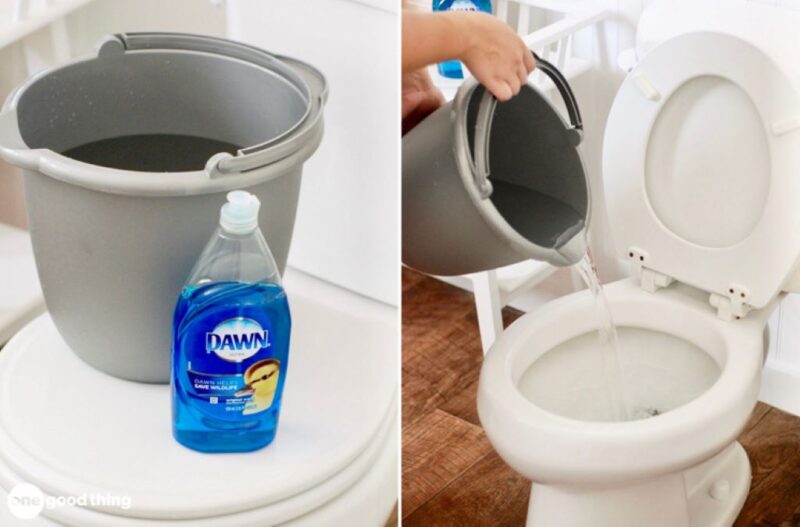To unclog a toilet, pour one cup of baking soda and two cups of vinegar into the toilet, followed by a half gallon of hot water. Let the solution sit overnight and then flush the toilet to check if the obstruction has cleared.
Additionally, you can try using a plunger by placing it firmly over the toilet bowl and plunging vigorously to create a vacuum. If the plunger doesn’t work, heat a bucket of hot water and carefully pour it into the toilet bowl from waist height to help dissolve and loosen the blockage.
Techniques For Unclogging A Toilet Without A Plunger

Dealing with a clogged toilet can be an unpleasant and frustrating experience. However, you don’t always need a plunger to fix the problem. In this article, we will explore three effective techniques for unclogging a toilet without a plunger. These techniques are simple, cost-effective, and easy to perform.
Using Dish Soap And Warm Water
One popular method for unclogging a toilet without a plunger is by using dish soap and warm water. Here’s how you can do it:
- Start by pouring a few cups of hot water into the toilet bowl. The hot water will help to soften the clog and make it easier to remove.
- Add a generous amount of dish soap into the toilet bowl. Dish soap is designed to break down grease and other substances, making it an effective solution for unclogging toilets.
- Allow the mixture of hot water and dish soap to sit in the toilet bowl for about 10 minutes. This will give the soap enough time to work on breaking down the clog.
- After 10 minutes, flush the toilet and see if the clog has cleared. If not, you can repeat the process or move on to another technique.
Using Baking Soda, Vinegar, And Hot Water
Another effective technique for unclogging a toilet without a plunger is by using baking soda, vinegar, and hot water. Follow these steps to try this method:
- Pour one cup of baking soda into the toilet bowl. Baking soda is a natural cleaner and deodorizer that can help break down the clog.
- Next, pour two cups of vinegar into the toilet bowl. The combination of baking soda and vinegar will create a fizzy reaction that can help dislodge the clog.
- Allow the mixture to sit in the toilet bowl for about 30 minutes. During this time, the fizzy reaction will work on breaking down the clog.
- After 30 minutes, pour a half gallon of hot water into the toilet bowl. The hot water will help to flush away the clog.
- Flush the toilet and check if the clog has cleared. If it hasn’t, you can repeat the process or try another technique.
Using A Toilet Brush Or Plumber’s Snake
If the above methods don’t work, you can try using a toilet brush or a plumber’s snake to manually remove the clog. Here’s how:
- If you have a toilet brush, insert it into the toilet bowl and plunge it up and down vigorously. This can help to dislodge the clog and allow it to be flushed away.
- If you have a plumber’s snake, insert the end of the snake into the toilet drain and slowly rotate it clockwise. Continue pushing the snake until you feel resistance from the clog. Once you’ve reached the clog, pull the snake out while rotating it counterclockwise to break up the clog.
- After using either the toilet brush or plumber’s snake, flush the toilet to see if the clog has cleared. If it hasn’t, you may need to repeat the process or consider calling a professional plumber.
Effective Tools For Unclogging A Toilet
When it comes to unclogging a toilet, having the right tools can make the job a whole lot easier. Whether you’re dealing with a minor clog or a stubborn blockage, there are several effective tools that can help you get the water flowing smoothly again. From liquid drain cleaners to snake augers, let’s explore these tools and how to use them.
Liquid Drain Cleaners
Liquid drain cleaners are a popular choice for unclogging toilets and other plumbing fixtures. These cleaners come in various formulas, including gel or foam-based solutions that work by breaking down organic matter, such as hair, toilet paper, and other debris that can cause blockages. Simply pour the recommended amount of cleaner into the toilet bowl, allowing it to sit for the specified time, and then flush the toilet to see the results. It’s important to note that not all liquid drain cleaners are suitable for toilets, so be sure to choose one that is specifically designed for this purpose.
Toilet Uncloggers
If you prefer a more manual approach, toilet uncloggers, also known as plungers, are a tried and true tool for unclogging toilets. These tools work by creating suction and pressure to loosen and dislodge the blockage. To use a plunger, place the rubber end firmly over the toilet bowl opening, ensuring a tight seal. Push down gently and then pull up quickly, repeating the motion several times. The suction created by the plunger can help dislodge the clog and restore proper water flow. Remember to clean and sanitize your plunger after each use.
Snake Augers
In cases where a plunger or liquid drain cleaner isn’t effective, a snake auger can be a valuable tool for unclogging toilets. A snake auger, also known as a plumbing snake or drain snake, is a flexible wire coil that can be manually inserted into the toilet drain. By rotating and extending the snake, it can reach further down the pipe, where it can break up or retrieve the blockage. To use a snake auger, carefully insert the coil into the toilet until you reach the obstruction. Twist the handle clockwise to extend the snake and then slowly retract it while continuing to rotate. This action can help break up the clog and restore proper drainage.
Alternative Methods For Unclogging A Toilet
When your toilet gets clogged and you don’t have a plunger handy, don’t worry! There are alternative methods you can try to unclog your toilet. These methods may not be as commonly used as plungers, but they can be just as effective in removing the blockage. In this article, we will explore three alternative methods for unclogging a toilet: using hot water, using DIY drain cleaner, and using household items.
Using Hot Water
One effective method for unclogging a toilet is using hot water. This method involves pouring hot water into the toilet bowl to help break down and flush away the blockage. Here’s how you can do it:
- First, boil a pot of water on the stove or use hot water from the tap. Make sure the water is not boiling hot to avoid cracking the porcelain.
- Carefully pour the hot water into the toilet bowl.
- Let the hot water sit in the bowl for a few minutes to soften the clog.
- Flush the toilet to see if the blockage has cleared. If not, repeat the process or try another method.
Using Diy Drain Cleaner
If hot water doesn’t do the trick, you can try using a DIY drain cleaner to dissolve the clog. Here’s a simple recipe you can make at home:
- Mix 1 cup of baking soda and 2 cups of vinegar in a bowl. The mixture will fizz and bubble, so be careful when pouring it into the toilet bowl.
- Pour the mixture into the toilet bowl and let it sit for a few hours or overnight.
- After the waiting period, flush the toilet to see if the clog has cleared. If not, you may need to try another method or call a professional plumber.
Using Household Items

If you don’t have a plunger, hot water, or DIY drain cleaner, you can try using common household items to unclog your toilet. Here are a few options:
- Dish Soap: Add a few squirts of dish soap into the toilet bowl, followed by hot water. Let it sit for a while and then flush to see if the clog has cleared.
- Straighten out a wire coat hanger and create a hook at one end. Carefully insert the hooked end into the toilet drain and try to remove the blockage by pulling it out.
- Cut off the bottom of a plastic bottle to create a makeshift plunger. Cover the bottle opening with a plastic bag and use it to plunge the toilet.
Remember, these household items may not always guarantee success in unclogging your toilet, so it’s always best to have a plunger or call a professional plumber if the clog persists.
Frequently Asked Questions Of Unclog Toilet
What Can You Pour Down A Toilet To Unclog It?
To unclog a toilet, you can pour one cup of baking soda and two cups of vinegar into the toilet, followed by a half gallon of hot water. Dish soap can also help. Let the solution sit overnight and then flush to see if the obstruction clears.
How Do You Clear A Badly Clogged Toilet?
To clear a badly clogged toilet, follow these steps: 1. Soften a plunger rubber under hot tap water to make it more effective. 2. Place the plunger over the toilet bowl, creating a vacuum, and plunge vigorously. 3. If the plunger doesn’t work, try pouring hot water from waist height into the bowl to dissolve the blockage.
4. If all else fails, use a toilet brush or plumber’s snake to break up the blockage.
How Do You Unblock A Toilet When The Plunger Doesn’t Work?
If the plunger doesn’t work, try pouring hot water into the toilet bowl from waist height. The heat can help dissolve the blockage. You can also make a DIY drain cleaner by combining baking soda, vinegar, and hot water. Allow it to sit overnight and then flush the toilet to check if the obstruction is cleared.
How Do You Unclog A Toilet When Nothing Works?
To unclog a toilet when nothing else works, try using hot water. Heat a bucket of water and carefully pour it into the toilet bowl from waist height. The heat can help dissolve the blockage and clear the way. Alternatively, you can try using a toilet brush or plumber’s snake to break up the clog.
Conclusion
To conclude, there are various methods to effectively unclog a toilet without the need for a plunger. From using hot water and dish soap to creating a DIY drain cleaner with vinegar and baking soda, these techniques can help loosen and clear the blockage.
However, it is important to exercise caution and avoid pouring boiling water directly into the toilet bowl. Explore the comprehensive guide on PVC double tee: Applications & benefits to discover the versatility and value this component brings to plumbing and mechanical systems. Just like the advantage of using PVC pipe unions, which allow for easy disassembly and reassembly of pipes, PVC double tees prove to be a valuable asset for efficient and adaptable installations.

